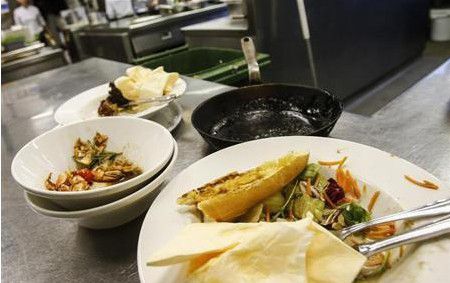全球粮食浪费触目惊心
爱思英语编者按:全球每年约有三分之一的粮食被浪费,浪费量大约为13亿吨。与此同时,生产和处理粮食所需的能源、水和化学制品也被浪费。

ROME, Sep 11 (Reuters) - The food the world wastes accounts for more greenhouse gas emissions than any country except for China and the United States, the United Nations said in a report on Wednesday.
路透社罗马9月11日 - 联合国粮农组织(FAO)周三发布题为《粮食浪费足迹》(The Food Wastage Footprint)的报告称,全球粮食浪费产生的温室气体排放,超过中国和美国以外其他任何国家的排放量。
Every year about a third of all food for human consumption, around 1.3 billion tons, is wasted, along with all the energy, water and chemicals needed to produce it and dispose of it.
全球每年约有三分之一的粮食被浪费,浪费量大约为13亿吨。与此同时,生产和处理粮食所需的能源、水和化学制品也被浪费。
Almost 30 percent of the world's farmland, and a volume of water equivalent to the annual discharge of the River Volga, are in effect being used in vain.
全球几乎有30%的农田和相当于俄罗斯伏尔加河年流量的水资源被白白消耗。
In its report entitled "The Food Wastage Footprint", the U.N. Food and Agriculture Organization (FAO) estimated that the carbon footprint of wasted food was equivalent to 3.3 billion tons of carbon dioxide per year.
联合国粮农组织在报告中预测,粮食浪费产生的碳足迹,相当于每年排放33亿吨二氧化碳。
If it were a country, it would be the world's third biggest emitter after China and the United States, suggesting that more efficient food use could contribute substantially to global efforts to cut greenhouse gases to limit global warming.
如果把粮食浪费造成的碳排放看成一个国家,那么则是继中国和美国之后的全球第三大温室气体排放国。这表明更有效地使用粮食,将能为减少温室气体排放以抑制气候变暖作出巨大贡献。
In the industrialized world, much of the waste comes from consumers buying too much and throwing away what they do not eat. In developing countries, it is mainly the result of inefficient farming and a lack of proper storage facilities.
在工业发达国家,多数粮食浪费与消费者购买太多、把没吃的扔掉有关。在发展中国家,农业效率低且缺乏适当的存储设施,是造成粮食浪费的主要原因。
"Food wastage reduction would not only avoid pressure on scarce natural resources but also decrease the need to raise food production by 60 percent in order to meet the 2050 population demand," the FAO said.
“减少浪费食物,不仅能避免对稀缺自然资源的压力,还能减轻需要提高粮食生产水平60%才能满足2050年的人口需求的压力。”联合国粮农组织称。
It suggested improving communication between producers and consumers to manage the supply chain more efficiently, as well as investing more in harvesting, cooling and packaging methods.
报告建议提高生产者和消费者之间的沟通,更有效地管理供应链,以及更多地投资于收获,冷却和包装方法。
It also said consumers in the developed world should be encouraged to serve smaller portions and make more use of leftovers. Businesses should give surplus food to charities, and develop alternatives to dumping organic waste in landfill.
它还说,在发达国家的消费者应鼓励服务弱势群体,更多地利用剩余粮食。企业应该捐给慈善机构剩余食品,开发替代食品以及有机废物倒入垃圾填埋场。
The FAO estimated the cost of the wasted food, excluding fish and seafood, at about $750 billion a year, based on producer prices.
联合国粮农组织估算,基于生产者价格,不包括鱼和海鲜,一年所浪费粮食的经济损失约为7,500亿美元。
The wasted food consumes about 250 cubic km of water and takes up about 1.4 billion hectares - much of it diverse natural habitat that has been cleared to make it arable.
被浪费的粮食所消耗的水约2.50亿方,耕地约1.4亿公顷 - 其中大部分是已被破坏的多样化的自然生态栖息地。